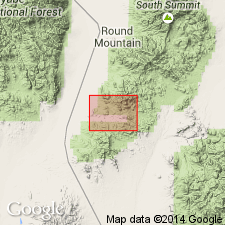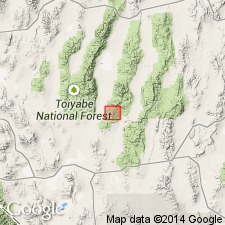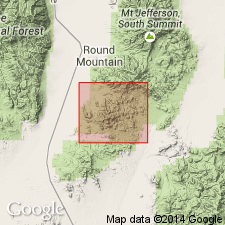
- Usage in publication:
-
- Diamond King member*
- Modifications:
-
- Named
- Dominant lithology:
-
- Tuff
- AAPG geologic province:
-
- Great Basin province
Summary:
Named from its prominence on Diamond King Hill, Manhattan district, southern Toquima Range, NV. Is second from uppermost named member (of four) of Esmeralda formation. Is chiefly massive, even-grained, porphyritic flows and tuff. Upper part is bedded tuff that "logically should have been included in overlying Bald Mountain lake-beds member [new of Esmeralda formation], but the impossibility of making any good separation in field rendered it advisable to include them in the Diamond King member." p.47. Thickness ranges from 100 to 800 ft. Overlies with erosional unconformity Round Rock member (new) of Esmeralda formation. Shown on geologic map of Manhattan district as probably late Miocene(?) age.
Source: GNU records (USGS DDS-6; Menlo GNULEX).

- Usage in publication:
-
- Diamond King Formation*
- Modifications:
-
- Revised
- Age modified
- Geochronologic dating
- AAPG geologic province:
-
- Great Basin province
Summary:
Diamond King Member (Esmeralda Formation) of Ferguson (1924) is raised to formational status and called Diamond King Formation due to miscorrelation with type Esmeralda. Contact with underlying Round Rock Formation identical to that defined by Ferguson (1924) between his Round Rock and Diamond King Members; contact with overlying Bald Mountain Formation (Bald Mountain Lake Beds Member of Ferguson, 1924) is similar to Ferguson (1924) with exclusion of some locally coarse-grained sedimentary beds that are now included in the Bald Mountain. Age is latest Oligocene based on K-Ar (biotite) and fission-track (zircon) ages of 25 Ma on underlying Round Rock Formation and 24.6 Ma on overlying rocks.
Source: GNU records (USGS DDS-6; Menlo GNULEX).

- Usage in publication:
-
- Diamond King Formation*
- Modifications:
-
- Areal extent
- AAPG geologic province:
-
- Great Basin province
Summary:
Shown on map of Manhattan caldera, Nye Co, NV, thus extending unit north and east of earlier map of Ferguson (1924). Exposed extensively within caldera where it is about 150 to 200 m thick. Characterized in hand specimens by conspicuous smoky quartz dipyramids. Source of unit is unknown; possibly derived from caldera now buried beneath alluvium of Big Smoky Valley west of Round Mountain.
Source: GNU records (USGS DDS-6; Menlo GNULEX).
For more information, please contact Nancy Stamm, Geologic Names Committee Secretary.
Asterisk (*) indicates published by U.S. Geological Survey authors.
"No current usage" (†) implies that a name has been abandoned or has fallen into disuse. Former usage and, if known, replacement name given in parentheses ( ).
Slash (/) indicates name conflicts with nomenclatural guidelines (CSN, 1933; ACSN, 1961, 1970; NACSN, 1983, 2005, 2021). May be explained within brackets ([ ]).

